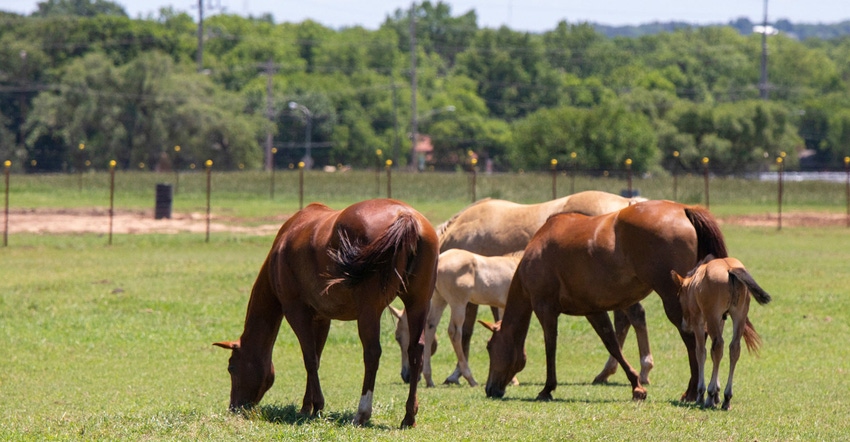
A nursing foal’s nutritional requirements will exceed the mare’s ability to supply nutrients to the foal through its milk a few months after birth, underscoring the need to provide access to solid foods.
Commonly called creep feeding, research indicates the practice will not only provide many of the necessary nutrients for sound bone and muscle growth, it also will lessen weaning stress, said Kris Hiney, Oklahoma State University Extension equine specialist with the university’s Department of Animal and Food Sciences.
“Consumption of creep feed is extremely variable between foals,” she said. “Most creep rations should be balanced to contain about 16% crude protein, 0.6% to 0.8% calcium and 0.4% to 0.6% phosphorus. Copper, zinc, iron, selenium, vitamin E and amino acids such as lysine also are important.”
Rations should include high-quality protein sources such as alfalfa meal, soybean meal or milk protein, and can be fed as pellets or as coarsely processed grains. Make sure they are palatable to promote consumption. A 3-month-old foal can consume about three pounds per day of a palatable feed, plus milk and pasture or hay. At that rate, a foal will consume about 3% of its body weight in dry matter, packing on 2.5 pounds or more each day.
"Foals will regulate their individual needs by consuming small amounts of creep feed frequently throughout the day if feeding free choice,” Hiney said.
The exact type of creep feeder needed will depend on the facilities in which the mares and foals are kept. Commercially manufactured creep feeders are available, though horse owners may prefer to build their own. A small pen that allows entry to a foal but through which a mare cannot fit will make a suitable creep feeder. Creep feeders should be designed so the openings are low enough in height to limit access by mares but at least a couple of inches above the wither height of the foals.
“A creep feeder needs to be quite sturdy to prevent a determined mare from pushing her way in,” Hiney said. “They can still crawl in if the feeder only limits mares by height.”
As foals grow, the height opening will need to be adjusted. The width of the opening also should allow for at least several inches of clearance from the foal’s body. A foal should be able to enter, eat, turn around and exit with no difficulty.
Another design consideration is to not provide access to too many foals at once and to observe the eating habits of the animals. Sixty square feet should be adequate to accommodate one or two foals. If a feeder is designed to feed multiple foals at once, have more than one exit so a foal doesn’t become trapped inside by another foal.
“If the horse manager is feeding them free choice, take care to provide enough feed for a timid foal; otherwise, a more dominant foal could consume all the grain,” Hiney said. “Unlimited resources are not guarded as fiercely. Be sure to provide fresh feed and keep the feeders clean.”
Commercially available creep feeders designed for stalls where mares are fed individually may be a more practical solution for horse owners with one or two mares. The bars of such feeders are spaced so that the mare’s muzzle won’t fit inside.
Regardless of the type of creep feeder used, Hiney recommended horse managers use an old trick to encourage foals to eat solid food: Place the feeder in a place frequented by the mare. Where mama goes the foal typically will want to follow.
Fact sheets detailing research-based information about best management practices for foals and young horses are available online through OSU Extension and at all OSU Extension county offices.
Source: is OSU, which is solely responsible for the information provided and is wholly owned by the source. Informa Business Media and all its subsidiaries are not responsible for any of the content contained in this information asset.
About the Author(s)
You May Also Like




